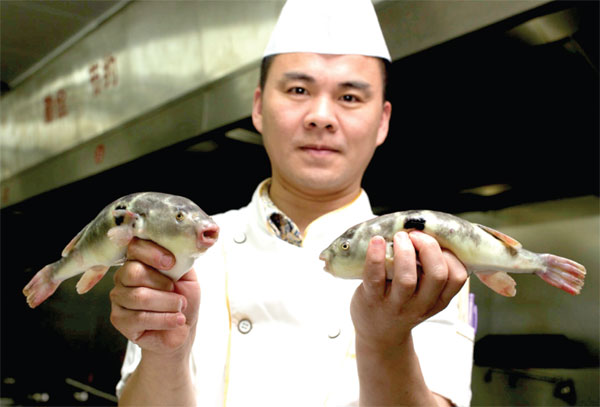where water feeds culture
Jiangyin's amazing aquaculture nourishes its human culture
Water, water, everywhere. Oh so much to eat.
Jiangyin's position on the banks of Taihu Lake - a freshwater body twice the size of Hong Kong - and the Yangtze River - near where the watercourse spills into the East China Sea - has sired a cuisine that converses through abundant aquaculture.
Its copious H2O makes the city in Jiangsu province an epicenter of the "Land of Fish and Rice", as the Yangtze Delta's greater southern swathe has long been christened.
Over 90 fish species are pulled from Jiangyin's neck of the world's third-largest river to be placed on plates, typically sopping with the sugar-and-soy sauce concoction that's Jiangyin's signature condiment.
Actual meats here are often as sweet as sweetmeats elsewhere - as in the confectionary kind.
So are the vegetables - many of which are also plucked from local waters and then smothered with sugar.
The fare that isn't at least drizzled, if not sodden, with the saccharine-and-savory potion rarely features zests like those injected by sourness or spiciness.

When not syrupy, Jiangyin cuisine bows to the beauty of blandness.
It shows the sophistication of simple tastes.
The city's position within Jiangsu province is perfect for snatching fattened saltwater fish as they wriggle up the Yangtze from the ocean to spawn.

It's just far enough from the delta's mouth that strong seawater flavors are purified by roiling rivers.
And it's just far enough from the reproduction destinations in the upper Yangtze that they haven't burned much of the oily fat they've hoarded for the voyage against the current.
Jiangyin's shads, balloon fish and sauries are consequentially acclaimed as among the world's best and were once mainstays of imperial meals.
|
Famous Jiangyin fish dish. photos by gao erqiang / China Daily |
Puffer fish occupy an expansive portion of celebrated recipes.
There are over a hundred ways to prepare them.
But, whichever way, it's a life-and-death requirement that certified chefs serve the dish, since the species' blood is awash with lethal tetrodotoxin.
Jiangyin Cuisine Association Chairman Wu Xieping says his favorite dish among Jiangyin's pantheon is globefish stewed in brown sauce.
"It's the most traditional preparation of the most traditional ingredient," the national-level chef says.
The city offers classes in cooking the species, which have attracted participants from 23 cities nationwide. Japan invited the Jiangyin Cuisine Association's former head to deliver the academic paper My Views on Cooking Yangtze Fish, after which World Cuisine crowned him as the "Chinese globefish king".
Arguably, the marine critter that relies on bloating and poisoning to avoid being eaten likely has little inkling of its top spot among local delicacies.
While puffers - proudly or not - claim the No 1 place among Jiangyin's aquatic offerings, second place is largely divided among its "three eights".
That's eight creatures - eels, mussels, clams, shrimp, fish, snails, frogs and turtles.
Eight veggies - wild rice, cress, water chestnuts, lotus roots, arrowheads, caltrop, gorgon fruit and asparagus.
And "eight big bowls" - a colloquial term for specific specialties served in seething broth, often including the aforementioned staples.
Fish-head soup is a separate specialty that appears in caldrons that sigh steam. Its venerated arrival at restaurants is heralded by three gong strikes.
That said, despite aquaculture's usurpation of Jiangyin's culinary hierarchy, many dishes hail from terrestrial origins.
Diners poke straws into pork shanks to slurp out marrow. They tear basketballs of bread apart with gloved hands. They drizzle raw eggs over sizzling stones and stir to scramble.
Wu doesn't believe globalization threatens Jiangyin cuisine's integrity.
Neither by virtue of outside culinary styles' penetration nor from growing international health concerns about sugar and salt.
"Tourism is thriving, and food is crucial to the travel industry," Wu says.
"People seek authenticity. The tradition of sugar and soy sauce will survive."
Globalization is working in the other direction, driving Jiangyin cuisine to make inroads outside the city and country, he believes.
Even if its sugary smack weakens over time, Jiangyin cuisine's soul will withstand, Wu says.
It may even flourish.
"The main ingredients are more important," Wu says.
"These will improve as the country enhances environmental protection."
The reduction of sugar and soy sauce would take at least a generation or two, Wu believes.
That'd be a case of boiling frog.
That's an allegory based on reality, in which the amphibian is foisted into a scalding pot and tries to escape versus when its vessel's temperatures are gradually increased and the animal never notices.
By the way, boiled frog is a Jiangyin dish.
erik_nilsson@chinadaily.com.cn
(China Daily 07/15/2016 page44)















